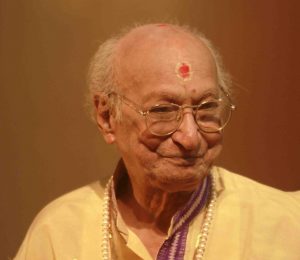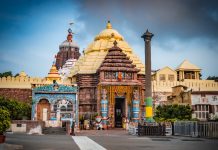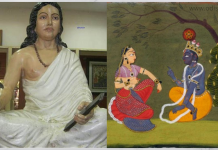Kedar Mishra
 A man of maverick simplicity, oblivious of his own genius and greatness, lived a complete life of eternal music. He sang behind the silver screen, mesmerized his fans on global stage and accompanied the best of Odissi dancers with utmost sincerity and devotion- with great sense of attachment he played whatever roles life prompted him to perform and amazingly he set extraordinary height for every sojourn of his creativity.
A man of maverick simplicity, oblivious of his own genius and greatness, lived a complete life of eternal music. He sang behind the silver screen, mesmerized his fans on global stage and accompanied the best of Odissi dancers with utmost sincerity and devotion- with great sense of attachment he played whatever roles life prompted him to perform and amazingly he set extraordinary height for every sojourn of his creativity.
Famous play back singers in Odia and southern films, maestro in Odissi style of singing, composer, teacher and devoted lover of Odissi art Pt. Raghunath Panigrahi (10 August 1932-25 August 2013)- has redefined every line of his artistic life with new verve and vigor. No doubt a great musician he was, also he was a man of kindest heart, a hero who never cares for his heroic aura. Music was his prime identity, but for his fans and followers he was the loveliest and kindest human being. Like a divine fragrance he embraced all who come across his fold.
He is like the tender breeze of spring (The way he pronounced Dheeeera samire..in Geeta Govinda), soothing, loving and a healing touch to every wounded heart.
Child of Divine Darkness
Born on 10th of August 1932 in a smaller town named Gunupur in the southern district of Rayagada, he was part of a large family where music was a way of family life. He belongs to the lesser known southern style of Odissi singing, absolutely free of Hindustani and Carntic impact. After Apanna Panigrahi and Tarini Patra, Pt. Raghunath was the last torch bearer of that rare style. With him an era was ended.
From the tiny town of Gunupur we was shifted to Puri and later sent to Madras or Chennai to learn music. His crystal clear voice and deeply moving rendition caught hold many an attentions and he becomes an established play back singer in southern films. Later he joined Odia film industry as a play back singer and scored his mega hits in the tracks like Susama go Tuma ange ange bhara madhu jochhana..or Na jaa radhika… in the golden era of All India Radio and Gramophone Records, dozens of his tracks had become highly popular and remained as undying classic.
Coming from a small town, the young singer becomes much sought after singer in Madras and that city had become Raghunath’s new life line. There he met his soul mate Sanjukta Mishra/panigrahi, later who becomes brand ambassador of Odishi dance and a legend on her own capacity. They fell in love and tied nuptial knot in Mumbai.
A style of His Own
Pt Raghunath Panigrahi was a versatile singer, stepped into every forms and styles of Indian music, starting from Classical to folk, from devotional to romantic, from film to dance numbers. His Bhajans and Odishi are distinct in style and bear a typical signature of Panditji’s own style. Though a classical maestro, he was open to all kind of experimentation.
Infusing Desi elements in classical genre was his hallmark. When he sings Salabega, the Muslim devotee of lord Jagannath he prefers a style fitting into the literary class of the poet. Likewise when he sings Modern poets like Gangadhar Meher, Madhusudan Rao or Laxmikanta Mohapatra, he chooses another style. Rupa rekha nahin hey sunya dehi..the famous Bhima Bhoi Bhajan of Panditji was a rupture in his own journey. Chandan Hajuri’s famous song Chaka nayanaku patita kehi…in his voice becomes an undying flow of surrender. When he sings Sabuthiru banchita kari….that goes deep into the depth of human heart evoking sympathy and spirituality. Sometime he prefers folk as his vehicle of melody…sri purusottama jiba mana..kalia dhana to lagi jau e jibana….can be taken as instances.
Odishi and Geeta Govinda
He was more known as Geeta Gobinda Panigrahi. Prithwiraj Kapoor, legendary actor of Indian cinema used to call him Geeta Gobinda Panigrahi. Leaving a highly promising career of play back singing, he fully devoted his life for Odissi and Geeta Gobinda singing. For many Indians Panigrahi’s Geeta Gobinda becomes their morning Raaga. Clarity, purity in diction, blend of perfect moods with Sur and absolute involvement of his voice with the text, make his Geeta Gobinda a household treasure.
The best thing about his rendering of Geeta Gobinda is that it is Trans cultural and truly metamorphosed into the love song of humanity. Apart from Geeta Gobinda, few immortal Odishi tracks of him are the proudest strength of Odishi school. Manasija manamohana….Ki nadare pranasangini…etc embolden his own style of Odishi. He was a colossus, huge and gigantic, superb and splendid.
Unison of Dance and Music
Raghunath Panigrahi and Sanjukta Panigrahi as a couple remains inseparable and their unison resulted in a grand repertory of dance based compositions. No Odishi dance recital is complete without panditji’s compositions. Initially he composed the Astapadis for Sanjukta, added few pure musical pieces like Yugmadwandwa Pallavi subsequently. His divine composition Ahe nila saila…becomes every dancer’s most seen after dream. Ardhanariswara, was a composition immortalized by Sanjukta in her elegant dance style. Later it was adopted and re defined by Nritya Gram ensemble, making the musical track unchanged.
He composed hundreds of musical pieces for many a dancers, starting from Sanjukta Panigrahi to Bijayini Satpathy. In dance scenario the grand troika, Raghunath, Sanjukta and Guru Kelucharan Mohapatra designed an era of excellence. Even today one can feel the magical spell of his music in Barsha Abhisara, based on Kalidasa’s Ritu Samhara and superbly danced by Sujata Mohapatra.
There are hundreds of his musical compositions for dance remains scattered and one must compile all his musical scores for historical references.



















Excellent.